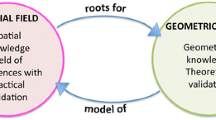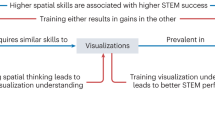Abstract
Many epistemic activities, such as spatial reasoning, sense-making, problem solving, and learning, are information-based. In the context of epistemic activities involving mathematical information, learners often use interactive 3D mathematical visualizations (MVs). However, performing such activities is not always easy. Although it is generally accepted that making these visualizations interactive can improve their utility, it is still not clear what role interaction plays in such activities. Interacting with MVs can be viewed as performing low-level epistemic actions on them. In this paper, an epistemic action signifies an external action that modifies a given MV in a way that renders learners’ mental processing of the visualization easier, faster, and more reliable. Several, combined epistemic actions then, when performed together, support broader, higher-level epistemic activities. The purpose of this paper is to examine the role that interaction plays in supporting learners to perform epistemic activities, specifically spatial reasoning involving 3D MVs. In particular, this research investigates how the provision of multiple interactions affects the utility of 3D MVs and what the usage patterns of these interactions are. To this end, an empirical study requiring learners to perform spatial reasoning tasks with 3D lattice structures was conducted. The study compared one experimental group with two control groups. The experimental group worked with a visualization tool which provided participants with multiple ways of interacting with the 3D lattices. One control group worked with a second version of the visualization tool which only provided one interaction. Another control group worked with 3D physical models of the visualized lattices. The results of the study indicate that providing learners with multiple interactions can significantly affect and improve performance of spatial reasoning with 3D MVs. Among other findings and conclusions, this research suggests that one of the central roles of interaction is allowing learners to perform low-level epistemic actions on MVs in order to carry out higher-level cognitive and epistemic activities. The results of this study have implications for how other 3D mathematical visualization tools should be designed.









Similar content being viewed by others
Notes
Here, ‘information-based’ is meant to suggest that epistemic activities of the learners revolve around the use of, working with, and thinking with the mathematical visualization.
Cognitive activities refer to mental activities, and epistemic activities refer to mental as well as knowledge-oriented activities. Even though this subtle difference exists between the two terms, for the sake of simplicity, they are used interchangeably in this paper. The same thing is true of activities and tasks. Activities are more open-ended in nature, but tasks may be given to us and be more goal-oriented and purposeful. Additionally, activities are broader than tasks and may encompass several levels of tasks and subtasks. Once again, the two terms, activities and tasks, are used interchangeably here.
Originally, 13 participants had signed up for each group. However, one participant in the MI Group had to leave in the middle of the study and was therefore dropped out of the study. Also, three participants in the SI Group did not show up for the study.
References
Billinghurst, M., & Weghorst, S. (1995). The use of sketch maps to measure cognitive maps of virtual environments. In Proceedings of virtual reality annual international symposium (VRAIS’95) (pp. 40–47).
Charistos, N. D., Teberekidis, V. I., Tsipis, C. A., & Sigalas, M. P. (2003). Design and development of a multimedia educational tool for interactive visualization and three-dimensional perception of vibrational spectra data of molecules. Education and Information Technologies, 8(4), 369–379.
Chen, C. (2004). Information visualization: Beyond the horizon. London, UK: Springer.
Dix, A. J., & Ellis, G. (1998). Starting simple–adding value to static visualization through simple interaction. In AVI’98: 4th international working conference on advanced visual interfaces, L’Aquilla, Italy (pp. 124–134). New York: ACM Press.
Dori, Y. J., & Barak, M. (2001). Virtual and physical molecular modeling: Fostering model perception and spatial understanding. Educational Technology & Society, 4(1), 61–74.
Ericsson, K., & Simon, H. (1993). Protocol analysis: Verbal reports as data (2nd ed.). Boston, MA: MIT Press.
Fiore, S. M., Cuevas, H. M., & Oser, R. L. (2003). A picture is worth a thousand connections: The facilitative effects of diagrams on mental model development and task performance. Computers in Human Behavior, 19, 185–199.
Groth, D. P., & Streefkerk, K. (2006). Provenance and annotation for visual exploration systems. IEEE Transactions on Visualization and Computer Graphics, 12(6), 1500–1510.
Hansen, C. D., & Johnson, C. R. (Eds.). (2005). The visualization handbook. Burlington, MA: Elsevier Butterworth-Heinemann.
Ho, C. H., Eastman, C., & Catrambone, R. (2006). An investigation of 2D and 3D spatial and mathematical abilities. Design Studies, 27(4), 505–524.
Hollan, J., Hutchins, E., & Kirsh, D. (2000). Distributed cognition: Toward a new foundation for human-computer interaction research. ACM Transactions on Computer-Human Interaction, 7(2), 174–196.
Hult, L., Irestig, M., & Lundberg, J. (2006). Design perspectives. Human-Computer Interaction, 21(1), 5–48.
Johnson, C., Moorhead, R., Munzner, T., Pfister, H., Rheingans, P., & Yoo, T. S. (2006). NIH/NSF visualization research challenges report. IEEE Computer Society Press.
Kirsh, D. (1995). The intelligent use of space. Artificial Intelligence, 73, 31–68.
Kirsh, D. (1996). Adapting the environment instead of oneself. Adaptive Behavior, 4(3–4), 415–452.
Kirsh, D. (1997). Interactivity and multimedia. Instructional Science, 25, 79–96.
Kirsh, D. (2003). Implicit and explicit representation. In L. Nadel (Ed.), Encyclopedia of cognitive science. New York, NY: Nature Pub. Group.
Kirsh, D., & Maglio, P. (1994). On distinguishing epistemic from pragmatic action. Cognitive Science, 18, 513–549.
Liang, H.-N., & Sedig, K. (2009). Characterizing navigation in interactive learning environments. Journal of Interactive Learning Environments, 17(1), 53–75.
Lowrie, T. (2002). The influence of visual and spatial reasoning in interpreting simulated 3d worlds. International Journal of Computers for Mathematical Learning, 7, 301–318.
Morey, J., & Sedig, K. (2004). Adjusting degree of visual complexity: An interactive approach for exploring four-dimensional polytopes. The Visual Computer: International Journal of Computer Graphics, 20, 1–21.
Napoli, A., & LE Ber, F. (2007). The Galois lattice as a hierarchical structure for topological relations. Annals of Mathematics and Artificial Intelligence, 49(1-4), 171–190.
Neth, H., & Payne, S. J. (2002). Thinking by doing: Epistemic actions in the Tower of Hanoi. In Proceedings of the twenty-fourth annual conference of the Cognitive Science Society, Fairfax, Virginia, August 8–10 (pp. 691–696).
Palais, R. S. (1999). The visualization of mathematics: Towards a mathematical exploratorium. Notices of the American Mathematical Society, 46(6), 647–658.
Peuquet, D. J. (2002). Representations of space and time. New York, NY: Guilford Press.
Presmeg, N. C. (1998). On visualization and generalization in mathematics. In Proceedings of twentieth annual meeting of the North American chapter of the International Group for the Psychology of Mathematics Education (North Carolina) (pp. 23–27).
Salomon, G. (Ed.). (1993). Distributed cognitions (learning in doing: Social, cognitive, and computational perspectives). New York, NY: Cambridge University Press.
Sedig, K. (2008). From play to thoughtful learning: A design strategy to engage children with mathematical representations. Journal of Computers in Mathematics and Science Teaching, 27(1), 65–101.
Sedig, K. (2009). Interactive mathematical visualizations: Frameworks, tools, and studies. In E. Zudilova-Seinstra, et al. (Eds.), Trends in interactive visualisation: A state-of-the-art survey (pp. 112–132). New York: Springer.
Sedig, K., & Liang, H.-N. (2006). Interactivity of visual mathematical representations: Factors affecting learning and cognitive processes. Journal of Interactive Learning Research, 17(2), 179–212.
Sedig, K., Rowhani, S., & Liang, H.-N. (2005). Designing interfaces that support formation of cognitive maps of transitional processes: An empirical study. Interacting with Computers: The Interdisciplinary Journal of Human-Computer Interaction, 17(4), 419–452. Elsevier.
Sedig, K., Rowhani, S., Morey, J., & Liang, H.-N. (2003). Application of information visualization techniques to the design of a mathematical mindtool: A usability study. Information Visualization, 2(3), 142–160.
Sedig, K., & Sumner, M. (2006). Characterizing interaction with visual mathematical representations. International Journal of Computers for Mathematical Learning, 11(1), 1–55.
Shah, P., & Miyake, A. (Eds.). (2005). The Cambridge handbook of visuospatial thinking. New York, USA: Cambridge University Press.
Spence, R. (1999). A framework for navigation. International Journal for Human-Computer Studies, 51, 919–945.
Spence, R. (2007). Information visualization: Design for interaction (2nd ed.). Harlow, UK: Pearson Education Limited.
Stylianou, D. (2002). On the interaction of visualization and analysis: The negotiation of a visual representation in expert problem solving. Journal of Mathematical Behavior, 21, 303–317.
Tergan, S.-O., & Keller, T. (Eds.). (2005). Knowledge and information visualization: Searching for synergies. Berlin: Springer.
Thomas, J. J., & Cook, K. A. (2005). Illuminating the path: The research and development agenda for visual analytics. National Visualization and Analytics Center.
Tory, M. (2003). Mental registration of 2D and 3D visualizations (An empirical study). In Proceedings of IEEE visualization ‘03 (pp. 371–378).
Tory, M., & Möller, T. (2004). Human factors in visualization research. IEEE Transactions on Visualization and Computer Research, 10(1), 72–84.
Tversky, B., & Lee, P. U. (1998). How space structures language. In C. Freksa, C. Habel, & K. F. Wender (Eds.), Spatial cognition: An interdisciplinary approach to representing and processing spatial knowledge (pp. 157–175). Berlin: Springer.
van Wijk, J. J. (2006). Views on visualization. IEEE Transactions on Visualization and Computer Graphics, 12(4), 421–432.
Wickens, C. D., Vincow, M., & Yeh, M. (2005). Design applications of visual spatial thinking. In P. Shah & A. Miyake (Eds.), The Cambridge handbook of visuospatial thinking (pp. 383–425). New York, USA: Cambridge University Press.
Wu, H.-K., Krajcik, J. S., & Soloway, E. (2001). Promoting understanding of chemical representations: Students’ use of a visualization tool in the classroom. Journal of Research in Science Teaching, 38(7), 821–842.
Acknowledgments
We would like to thank the reviewers of this article for their valuable comments. This research has been funded by the Natural Sciences and Engineering Research Council of Canada.
Author information
Authors and Affiliations
Corresponding author
Rights and permissions
About this article
Cite this article
Liang, HN., Sedig, K. Role of Interaction in Enhancing the Epistemic Utility of 3D Mathematical Visualizations. Int J Comput Math Learning 15, 191–224 (2010). https://doi.org/10.1007/s10758-010-9165-7
Published:
Issue Date:
DOI: https://doi.org/10.1007/s10758-010-9165-7




